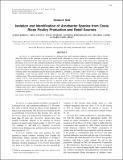| dc.contributor.author | Zumbado, Leana | |
| dc.contributor.author | Barboza, Karol | |
| dc.contributor.author | Angulo, Irina | |
| dc.contributor.author | Redondo-Solano, Mauricio | |
| dc.contributor.author | Castro, Eduardo | |
| dc.contributor.author | Arias, María Laura | |
| dc.date.accessioned | 2020-05-22T17:31:38Z | |
| dc.date.available | 2020-05-22T17:31:38Z | |
| dc.date.issued | 2017-04-03 | |
| dc.identifier.uri | http://hdl.handle.net/11056/17404 | |
| dc.description.abstract | Arcobacter is a gram-negative rod recognized as a potential food- and waterborne pathogen; nevertheless, little is known about the effects of this pathogen on human and animal health. Although Arcobacter species are commonly found in nature, poultry is suspected to be the main vehicle for the transmission of this pathogen. The aims of this work were to determine the prevalence of Arcobacter spp. in broilers produced in Costa Rica for human consumption and to analyze the pathogenic capacity of the isolates through the detection of virulence genes. One hundred fifty-two samples of cecal content (87 farms), 104 samples of carcass rinse after chiller (six processing plants), and 96 carcass rinses from as many retail stores were analyzed. The suspicious isolates were identified using genus-specific PCR, and species-level identification was achieved with a multiplex PCR. Virulence genes were identified using the protocol described by L. Douidah, L. de Zutter, J. Baré, P. De Vos, P. Vandamme, O. Vandenberg, A.-M. Van den Abeele, and K. Houf (J. Clin. Microbiol. 50:735–741, 2012), which includes nine different virulence genes. The overall isolation frequency of Arcobacter was 6.5% (n = 23). Eight (34.8%) of the isolates came from cecal content, 2 (8.7%) were isolated from samples taken after chiller, and 13 (56.5%) were from retail stores. The species isolated included A. thereius (30.4%), A. butzleri (21.7%), A. skirrowii (4.3%), and A. cibarius (4.3%). The remaining samples were classified as Arcobacter sp. Gene tlyA was the most prevalent virulence gene, present in 9 of 23 samples analyzed; genes hecA and pldA were present in one only strain each. A strain of A. butzleri isolated from a retail store presented the highest number of virulence genes (five), and 11 samples did not present any of the genes analyzed. The results obtained suggest that the presence of virulent Arcobacter isolates in the poultry production chain from Costa Rica could be a risk for individuals who consume the contaminated product. | es_ES |
| dc.description.abstract | Arcobacteris es una varilla gram-negativa reconocida como un posible patógeno transmitido por los alimentos y el agua; Sin embargo, poco se sabe sobre los efectos de este patógeno en la salud humana y animal. Aunque las especies de arcobacterias se encuentran comúnmente en la naturaleza, se sospecha que las aves de corral son el principal vehículo para la transmisión de este patógeno. Los objetivos de este trabajo fueron determinar la prevalencia de Arcbacterspp. en pollos de engorde producidos en Costa Rica para consumo humano y para analizar la capacidad patogénica de los aislamientos mediante la detección de genes de virulencia. Se analizaron ciento cincuenta y dos muestras de contenido cecal (87 granjas), 104 muestras de enjuague de carcasa después del enfriador (seis plantas de procesamiento) y 96 enjuagues de carcasa de tantas tiendas minoristas. Los aislados sospechosos se identificaron mediante PCR específica de género, y la identificación a nivel de especie se logró con una PCR múltiple. Los genes de virulencia se identificaron utilizando el protocolo descrito por L. Douidah, L. de Zutter, J. Bar ́e, P. De Vos, P. Vandamme, O.Vandenberg, A.-M. Van den Abeele y K. Houf (J. Clin. Microbiol. 50: 735–741, 2012), que incluye nueve genes de virulencia diferentes. La frecuencia de aislamiento general de Arcobacter fue de 6.5% (n = 23). Ocho (34.8%) de los aislamientos vinieron del contenido cecal, 2 (8.7%) fueron aislados de muestras tomadas después del enfriador y 13 (56.5%) fueron de tiendas minoristas. Las especies aisladas incluyeron A. thereius (30.4%), A. butzleri (21,7%), A. skirrowii (4.3%), y A. cibarius (4,3%). Las muestras restantes se clasificaron como Arcobactersp. Gene tlyA fue el gen de virulencia más prevalente, presente en 9 de 23 muestras analizadas; geneshec Aandpld estuvieron presentes en una sola cepa cada uno. Una cepa de A. butzleriisolated de una tienda minorista presentó el mayor número de genes de virulencia (cinco), y 11 muestras no presentaron ninguno de los genes analizados. Los resultados obtenidos sugieren que la presencia de arcobacterisolatos virulentos en la cadena de producción avícola de Costa Rica podría ser un riesgo para las personas que consumen el producto contaminado. | es_ES |
| dc.description.sponsorship | Universidad Nacional, Costa Rica | es_ES |
| dc.language.iso | spa | es_ES |
| dc.publisher | Journal of food protection | es_ES |
| dc.rights | Attribution-NonCommercial-NoDerivatives 4.0 Internacional | |
| dc.rights.uri | http://creativecommons.org/licenses/by-nc-nd/4.0/ | |
| dc.source | Journal of Food Protection, Vol. 80, No. 5, Pages 779–782, 2017 | es_ES |
| dc.subject | POLLOS DE ENGORDE | es_ES |
| dc.subject | CONTROL DE CALIDAD | es_ES |
| dc.subject | VIROLOGIA VETERINARIA | es_ES |
| dc.subject | BACTERIAS | es_ES |
| dc.subject | ARCOBACTER | es_ES |
| dc.subject | FATTENING CHICKENS | es_ES |
| dc.subject | VIRULENCE GENES | es_ES |
| dc.title | Isolation and identification of Arcobacter species from Costa Rican poultry production and retail sources | es_ES |
| dc.type | http://purl.org/coar/resource_type/c_6501 | es_ES |
| dc.description.procedence | Universidad Nacional, Costa Rica | es_ES |
| dc.identifier.doi | 10.4315/0362-028X.JFP-16-394 | |


